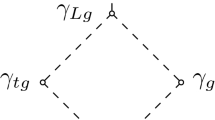Abstract
In 2014, Desormeaux et al. (Discrete Math 319:15–23, 2014) proved a relationship between the annihilation number and 2-domination number of a tree. In this note, we provide a family of bounds for the 2-domination number of a tree based on the amount of vertices of small degree. This family of bounds extends current bounds on the 2-domination number of a tree, and provides an alternative proof for the relationship between the annihilation number and the 2-domination number of a tree that was shown by Desormeaux et al.
Similar content being viewed by others
References
Blidia M, Chellali M, Favaron O (2005) Independence and 2-domination in trees. Australas J Combin 33:317–327
Caro Y, Pepper R (2014) Degree sequence index strategy. Australas J Combin 59:1–23
Caro Y, Roditty Y (1990) A note on the \(k\)-domination number of a graph. Internat J Math Math Sci 13(1):205–206
Chellali M, Favaron O, Hansberg A, Volkmann L (2012) \(k\)-domination and \(k\)-independence in graphs: a survey. Graphs Combin 28(1):1–55
DeLaViña E (2005) Written on the wall II, (conjectures of graffiti.pc). http://cms.uhd.edu/faculty/delavinae/research/wowii. Accessed August 10, 2015
DeLaViña E, Larson CE, Pepper R, Waller B (2010) Graffiti.pc on the 2-domination number of a graph. In: Proceedings of the forty-first southeastern international conference on combinatorics, graph theory and computing, vol 203, pp 15–32
Desormeaux WJ, Haynes TW, Henning MA (2013) Relating the annihilation number and the total domination number of a tree. Discrete Appl Math 161(3):349–354
Desormeaux WJ, Henning MA, Rall DF, Yeo A (2014) Relating the annihilation number and the 2-domination number of a tree. Discrete Math 319:15–23
Hansberg A, Meierling D, Volkmann L (2011) Independence and \(k\)-domination in graphs. Int J Comput Math 88(5):905–915
Haynes TW, Hedetniemi ST, Slater PJ (1998) Fundamentals of domination in graphs, vol 208., Monographs and textbooks in pure and applied mathematicsMarcel Dekker Inc, New York
Patterson SC (2015) 2-Domination and annihilation numbers. ProQuest LLC, Ann Arbor, thesis (Undergraduate Honors)–University of Southern Mississippi
Pepper R (2010) Implications of some observations about the \(k\)-domination number. In: Proceedings of the forty-first southeastern international conference on combinatorics, graph theory and computing, vol 206, pp 65–71
Pepper RD (2004) Binding independence. ProQuest LLC, Ann Arbor, thesis (Ph.D.)–University of Houston
Author information
Authors and Affiliations
Corresponding author
Rights and permissions
About this article
Cite this article
Lyle, J., Patterson, S. A note on the annihilation number and 2-domination number of a tree. J Comb Optim 33, 968–976 (2017). https://doi.org/10.1007/s10878-016-0019-7
Published:
Issue Date:
DOI: https://doi.org/10.1007/s10878-016-0019-7




